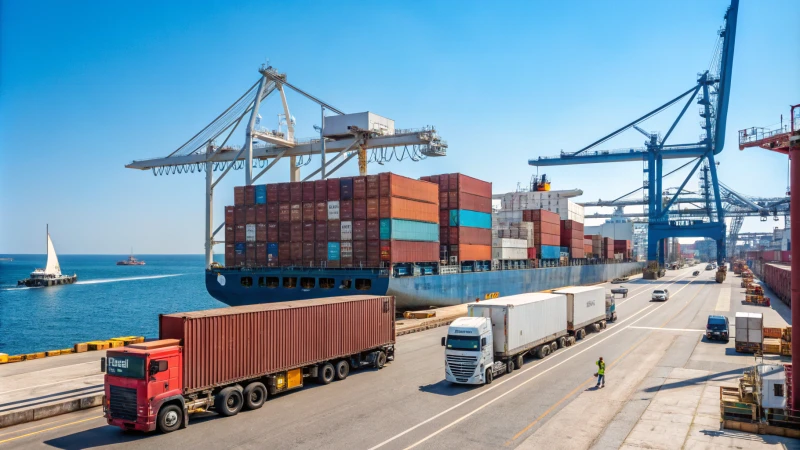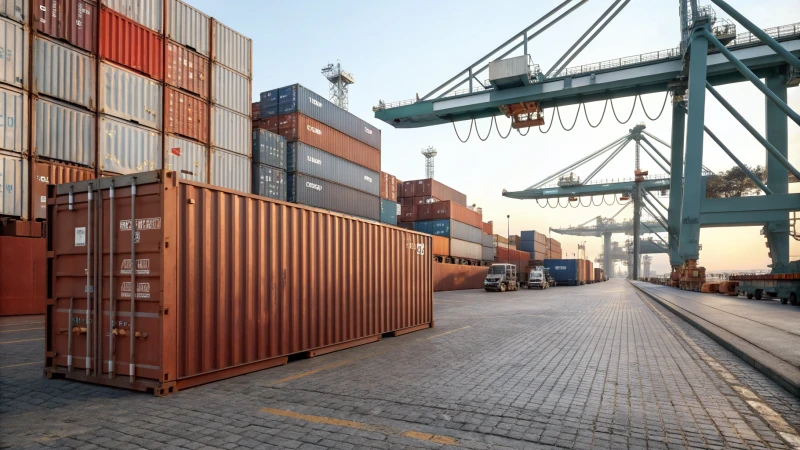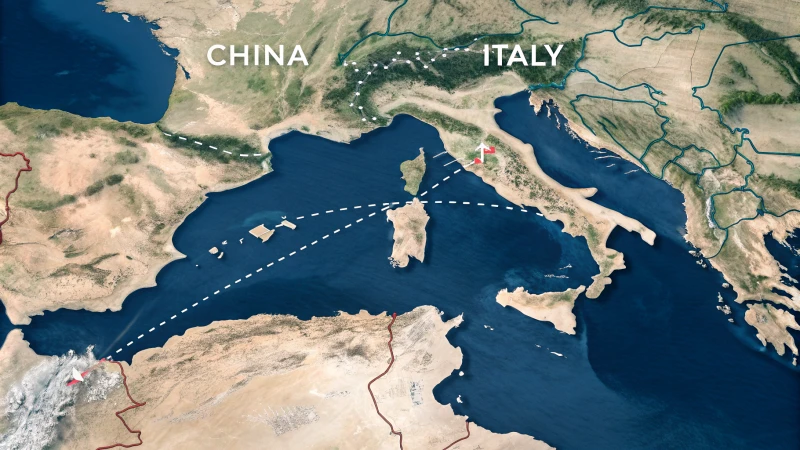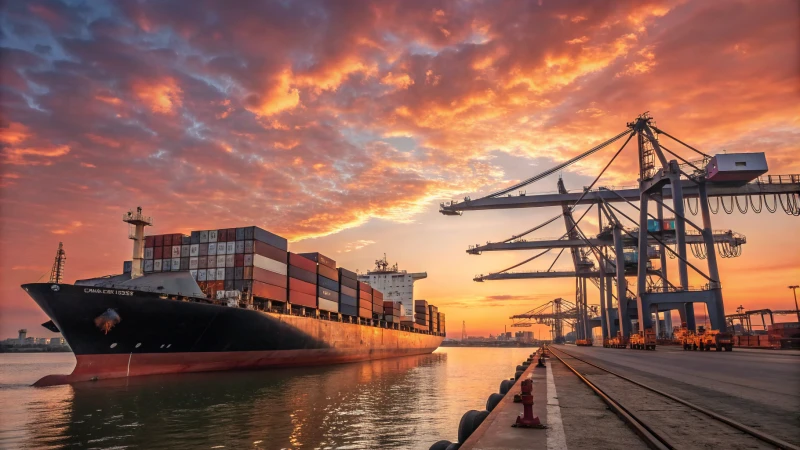Thinking about sending a container from China to Italy? I understand! Calculating the costs might seem really confusing. However, this is a very important step for planning your shipping process well.
Shipping costs for a container from China to Italy usually fall between $2500 and $5200. Container size and shipping route affect these prices. Understanding this helps you plan cleverly and escape surprise charges.
The first time I arranged a shipment, the costs were very confusing. Understanding the details really helped me find my way. Shipping a container from China to Italy usually costs between $2500 and $5200. Size of the container and the shipping path affect the price. Very important to think about these factors when planning your budget.
Shipping costs from China to Italy can exceed $5000.True
This claim reflects the upper range of typical shipping costs for containers.
All shipping routes from China to Italy cost the same.False
This claim is false as costs vary based on the specific shipping route chosen.
What Factors Influence Shipping Costs from China to Italy?
Shipping goods from China to Italy often feels like solving a complex puzzle. People must understand the factors affecting the cost of shipping. This understanding is essential. It really helps in managing the logistics budget smartly.
Shipping costs from China to Italy depend on several important factors. Container size and shipping routes are crucial. Fuel prices also play a big role. Customs fees matter too. The choice of the shipping company really affects the cost. Knowing these factors helps you manage your budget well. Budget management becomes easier. Understanding is key to effective budgeting.

Container Size
The size of the shipping container is one of the primary factors influencing costs. Generally, a 20ft container costs between $2500 to $4200, while a 40ft container ranges from $4000 to $5200.
Choosing the right size can significantly impact your shipping budget. For instance, if you are importing consumer electronics, consider how much space your products will occupy. I chose the 40ft to maximize shipment and save on future fees. Smart choices can really save money!
Shipping Route
The chosen shipping route can also affect costs and transit times. Some routes may be more direct but could have higher fees due to tolls or port charges.
For example, I once took a route that seemed to save time but ended up being expensive due to hidden fees. Always check details and consider overall costs.
Shipping Method
The method of shipping you select, whether air freight or sea freight, will greatly influence your expenses. Air freight is faster but typically costs more, making it suitable for urgent shipments.
Conversely, sea freight is cost-effective for bulk shipments; however, it requires more time for delivery. Choose based on how quickly you need the goods and your budget.
Fuel Prices
Fluctuating fuel prices can lead to variations in shipping costs. When fuel prices increase, carriers often pass on these costs to customers.
It's wise to stay updated on fuel price trends1 as they can impact your overall logistics budget.
Customs Fees and Import Taxes
Don’t overlook customs fees and import taxes, which can add to the final shipping cost. Each country has its own regulations and tariffs based on the nature of the goods being imported.
Understanding these fees in advance can help you avoid unexpected expenses. Consider researching customs regulations2 specific to Italy for better planning.
Chosen Shipping Company
Different freight forwarders have varied pricing structures based on their services, reputation, and efficiency. It’s essential to compare quotes from multiple companies to find the best deal while ensuring reliable service.
Contact freight forwarders3 experienced in China-Italy shipping for customized solutions; it probably improves your logistics experience.
Container size significantly affects shipping costs.True
The size of the shipping container directly influences the overall cost, with larger containers generally being more expensive to ship.
Air freight is cheaper than sea freight for bulk shipments.False
Sea freight is usually more cost-effective for bulk shipments, while air freight tends to be pricier due to speed.
How Do Container Sizes Affect Shipping Prices?
Have you ever thought about how the size of a shipping container affects its price? This question came up a lot in my own logistics experience. Knowing these details really saves money and reduces stress when shipping goods. Very important.
**Container sizes play a big role in deciding shipping prices. A 20ft container usually costs between $2500 and $4200, while a 40ft container costs from $4000 to $5200. Volume, weight and shipping routes greatly affect these prices. Choosing the right container based on your needs and budget is very important.
Knowing these facts helps save money and effort when planning shipments. It is very helpful.
Container Sizes and Costs
Container sizes are not just numbers. They greatly impact your shipping expenses. Over time, I learned that 20ft and 40ft containers have their own costs and benefits.
20ft Container꞉ At first, I often picked a 20ft container, costing between $2500 and $4200 for shipments from China to Italy. This size fit smaller shipments perfectly, letting me keep costs down while carrying different goods.
40ft Container꞉ As my business grew, I needed more 40ft containers, ranging from $4000 to $5200. These containers carry twice the size of smaller ones, perfect for bigger shipments of larger items.
Factors Affecting Shipping Prices by Container Size
Several things affect how container sizes impact shipping costs꞉
Volume and Weight
Bigger containers can mean lower costs for each cargo piece transported. If you have more items to send, a larger container might save you money! This is a big deal.
Shipping Route
The route picked can change costs a lot. Longer routes often mean higher fuel and handling charges. I saw the costs rise this way myself.
Shipping Company
Different transport companies have unique price policies based on their efficiency and partners. It really pays to look around and compare prices! This trick is worth remembering.
Cost Comparison Table
Other Things to Consider
When picking a container size, remember these extra points꞉
Cargo Type꞉ Some goods need particular container sizes to avoid damage.
Frequency of Shipments꞉ Shipping often? Bigger containers might work better.
Customs and Duties꞉ Bigger containers might face different tariff rates based on total cargo value. Customs matters!
By knowing how container sizes affect shipping prices, I’ve made smart choices that meet my needs and stay within budget. This knowledge has really helped optimize supply chains and keep operations smooth. Every business owner wants this!**

Understanding Container Sizes and Their Costs
At the beginning of my import business from China, I felt really confused by the many options, especially the container sizes. Every container had its own price and benefits. Picking the wrong one could lead to losses, while the right choice could bring profits. I want to share some important lessons I learned during this journey.
Container sizes play a crucial role in determining shipping prices, as they directly influence the volume and weight capacity of cargo that can be transported. The most common sizes are 20ft and 40ft containers, with each size offering distinct pricing structures and benefits.
-
20ft Container: Typically costs between $2500 to $4200 for shipping from China to Italy. This option is ideal for smaller shipments, offering sufficient space for various goods, while being more economical for lighter loads.
-
40ft Container: Ranges from $4000 to $5200, making it suitable for larger shipments. It can carry double the volume of a 20ft container, thus providing a cost-effective solution for heavy and bulkier items.
Factors Influencing Shipping Prices by Container Size
Several factors impact how container sizes affect shipping costs:
-
Volume and Weight: Larger containers can accommodate more goods, often leading to a lower cost per unit of cargo transported. Learn more about volume pricing4.
-
Shipping Route: The distance and chosen shipping route significantly influence pricing. Longer routes typically incur higher costs due to fuel and handling charges.
-
Shipping Company: Different freight forwarders may have varying pricing structures based on their operational efficiencies and partnerships. Compare shipping companies here5.
Cost Comparison Table
| Container Size | Estimated Cost | Volume Capacity | Typical Use Cases |
|---|---|---|---|
| 20ft | $2500 - $4200 | 33 cubic meters | Small shipments, personal goods |
| 40ft | $4000 - $5200 | 67 cubic meters | Bulk items, e-commerce products |
Additional Considerations
When selecting a container size, consider:
- Cargo Type: Different products may require specific container sizes to optimize space and reduce damage risks.
- Frequency of Shipments: Regular shipments may benefit from larger containers to maximize efficiency.
- Customs and Duties: Larger containers may also attract different tariff rates based on the total value of the cargo. Explore customs regulations6.
By understanding how container sizes influence shipping prices, businesses can make informed decisions that align with their logistical needs and budget constraints. This knowledge is essential for optimizing supply chains and ensuring cost-effective operations.
20ft containers are cheaper than 40ft containers for shipping.True
20ft containers typically cost between $2500 to $4200, while 40ft containers range from $4000 to $5200, making the former more economical.
Shipping costs are unaffected by container size.False
Container size directly influences shipping prices, with larger containers often leading to lower costs per unit of cargo transported.
What Additional Fees Should You Consider When Shipping?
Have you ever been surprised by your shipping bill? I know I have! Knowing extra charges helps with proper budgeting. I want to share what I have learned through experience.
Think about shipping costs and don't forget extra fees such as packaging, insurance, handling charges, customs duties and carrier surcharges. These elements are key to figuring out your full shipping costs correctly. They matter a lot.
When shipping goods, especially in a global context, understanding the additional fees that may arise is essential for accurate budgeting and planning. Here are some of the key fees to consider:
Packaging Costs
Proper packaging ensures that your products arrive safely. This can include:
| Type of Packaging | Estimated Cost |
|---|---|
| Boxes | $2 - $10 each |
| Bubble Wrap | $0.50 - $1 per ft |
| Pallets | $15 - $25 each |
I underestimated packaging at first. Proper packaging protects your items. Poor packaging can lead to damage. I sent a fragile item once and it broke because I used cheap packing materials. Don't let this happen to you! Add these costs to your budget.
Make sure to include these costs in your calculations to avoid surprises. For more insights on shipping best practices7, you can explore this further.
Insurance Fees
Insurance is a critical aspect of shipping, particularly for high-value goods. The cost typically ranges from 1% to 3% of the declared value of the shipment. Consider the following:
- High-value Items: For items valued over $1,000, opting for insurance can protect against loss or damage.
- Carrier-specific Insurance: Each carrier may have different rates and policies, so compare them to find the best fit.
Insurance really matters for shipping, especially with expensive items. Losing something valuable without coverage is bad. Here are some things to know:
- High-value Items: If items cost over $1,000, get insurance. It gives peace of mind.
- Carrier-specific Insurance: Rates and rules vary by carrier. Compare them carefully.
For a detailed overview of shipping insurance options8, check out our recommendations.
For more about shipping insurance9, check our tips. It may save you stress.
Handling Fees
Handling fees cover the labor involved in processing your shipment. They can vary based on the shipping company and the complexity of your order. Some common handling fees include:
- Warehouse Handling: $5 - $15 per package
- Loading Charges: Can be $50 or more depending on cargo size and complexity.
Handling fees quietly raise shipping costs as they cover labor for preparing shipments and differ greatly. Here’s what I noticed:
- Warehouse Handling: Costs are around $5 to $15 per package.
- Loading Charges: These can be $50 or more, based on size and handling needs.
These charges can significantly add to your shipping costs, so it’s vital to inquire about them beforehand. Always ask for these fees first, to avoid surprises. If you want to control these costs, learn about handling logistics10 for better cost management.
Customs Duties and Taxes
When shipping internationally, customs duties and taxes can add considerable costs:
- Import Duties: Typically between 0% to 20%, depending on the product type and country of origin.
- VAT or GST: Value-added tax can also apply, varying by region; this is typically around 20% in many countries.
Sending items internationally? Customs duties and taxes are unavoidable. Here's a simple view of what you may face:
- Import Duties: Typically from 0% to 20%, depending on the item and origin.
- VAT or GST: Maybe up to 20% in many areas.
Understanding these fees helps avoid unexpected expenses; knowing these details has made my shipping much easier!
For more details about customs regulations11 before shipping,
you can find more details about customs rules (PLACEHOLDER_DEFGHIJKLM).
Surcharges from Carriers
Many carriers impose surcharges that can vary seasonally or based on specific circumstances; some common surcharges include:
- Fuel Surcharge: Typically a percentage added to base rates based on current fuel prices.
- Peak Season Surcharge: Charged during high demand seasons such as holidays.
Carriers often include surcharges that change with seasons or events; double-check these with your carrier so the bill doesn't surprise you!
For further details on carrier pricing structures12, refer to our comprehensive guide.
Packaging costs can range from $2 to $25 per shipment.True
Packaging costs vary widely based on materials used, impacting total shipping expenses significantly.
Insurance fees for shipping are always 3% of the shipment value.False
Insurance fees typically range from 1% to 3%, not a fixed 3% for all shipments.
What Are the Estimated Shipping Times from China to Italy?
Sending products from China to Italy sometimes feels like a very challenging job, especially when trying to understand the time it takes. I recall my first experience with this - it was both thrilling and confusing! Let's explore what to expect.
Shipping from China to Italy by air usually takes 3-7 days. Sea freight often takes 25-35 days for both 20ft and 40ft containers. Remember to include customs procedures and seasonal changes for true delivery times. Reliable delivery depends on these factors.

Factors Influencing Shipping Times
Shipping times from China to Italy can be influenced by various factors, including:
- Shipping Method: Different methods such as air freight, sea freight, and express services offer varying delivery speeds. Air freight is very fast, often taking only 3-7 days, while sea freight can take 25-35 days. I’ve tried both - air freight for quick deliveries and sea freight for large shipments. Each has advantages and disadvantages!
- Customs Clearance: Customs regulations can affect delivery time. This is a crucial part that maybe speeds up or slows down things. I learned that incomplete papers cause delays - so now I always double-check everything!
- Seasonal Demand: Shipping during busy times like holidays causes delays. The first year I shipped during the holidays, I underestimated the load and had to wait longer. Important lesson!
Understanding these factors can help businesses better plan their shipments and manage expectations.
Estimated Transit Times by Shipping Method
Here’s a comparison of estimated shipping times based on common shipping methods from China to Italy:
| Shipping Method | Estimated Time Frame | Cost Range |
|---|---|---|
| Air Freight | 3-7 days | $50 - $200 |
| Sea Freight (20ft) | 25-35 days | $2,500 - $4,200 |
| Sea Freight (40ft) | 25-35 days | $4,000 - $5,200 |
| Express Services | 1-3 days | $6,000 - $12,000 |
This table outlines the typical times and costs associated with different shipping methods, providing a clear overview for importers planning shipments.
Preparing for Your Shipment
To ensure timely delivery:
- Choose the Right Carrier: Do your research! I found that choosing a carrier with a good reputation makes a big difference. Explore more about carrier options13.
- Documentation Preparation: Organize all your paperwork. Ensure that all shipping documents are accurate and complete to avoid customs delays. Once, I faced delays because my invoices lacked important details - I now use checklists!
- Tracking Your Shipment: Most carriers offer tracking tools which I strongly recommend using. Use tracking tools provided by your freight forwarder to monitor the status of your shipment in real-time.
By taking these steps, you can improve the chances of a smooth shipping process from China to Italy.
Additional Considerations
When planning shipments from China to Italy, consider potential delays due to:
- Weather Conditions: Bad weather disrupts shipping plans. One winter my shipment was delayed by storms - now I always check the weather!
- Global Events: Events like strikes or pandemics may disrupt supply chains. Situations like strikes or pandemics disturb supply lines; stay informed about logistics news to spot any issues. Stay informed about global logistics.
By keeping these considerations in mind and preparing early helps you avoid problems. Trust me; preparation saves a lot of stress!
Air freight from China to Italy takes 3-7 days.True
Air freight is the fastest shipping method, allowing delivery from China to Italy within a week.
Sea freight always takes less than 25 days from China to Italy.False
Sea freight typically requires 25-35 days for delivery, depending on various factors.
Conclusion
Learn about the shipping costs from China to Italy, which range from $2500 to $5200 based on container size, routes, and additional fees.
-
Learn how customs fees impact your total shipping expenses. ↩
-
Discover the latest trends in fuel prices and their effect on shipping costs. ↩
-
Find tips on choosing a reliable freight forwarder to optimize your shipping strategy. ↩
-
Discover detailed insights on how container sizes influence shipping costs and make informed decisions for your logistics. ↩
-
Find out the best practices in choosing container sizes for cost-effective shipping solutions. ↩
-
Learn about customs duties related to different container sizes to optimize your shipping expenses. ↩
-
This link provides insights into various shipping fees that can affect your budget significantly. ↩
-
Discover detailed options for insuring your shipments to protect against loss or damage. ↩
-
Discover detailed options for insuring your shipments to protect against loss or damage. ↩
-
Learn about managing handling fees effectively to control your shipping expenses. ↩
-
Get essential information on customs duties and taxes to prevent unexpected costs. ↩
-
Explore how carrier surcharges can impact your total shipping costs. ↩
-
Discover detailed insights on shipping times and methods between China and Italy to help optimize your logistics planning. ↩




